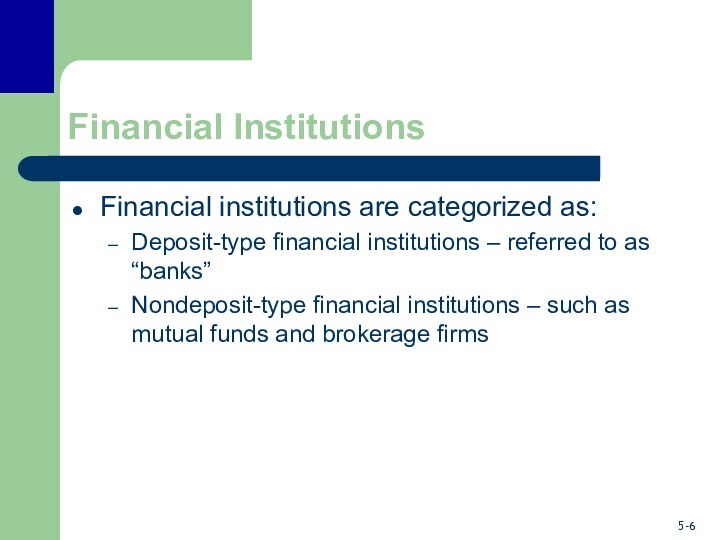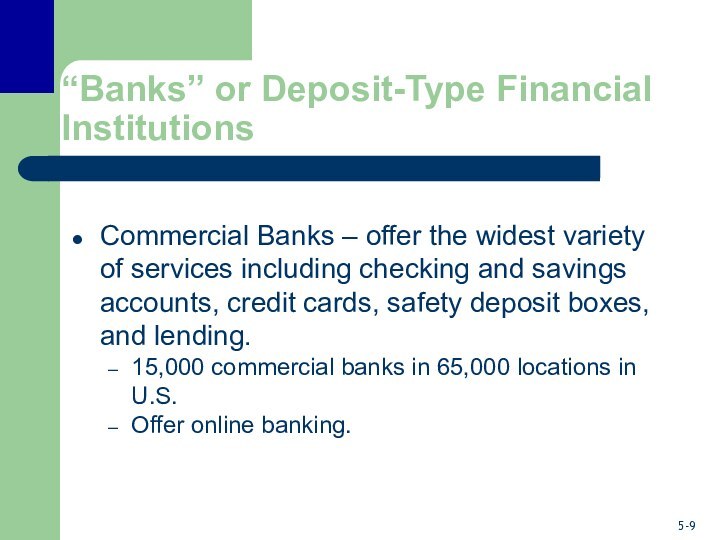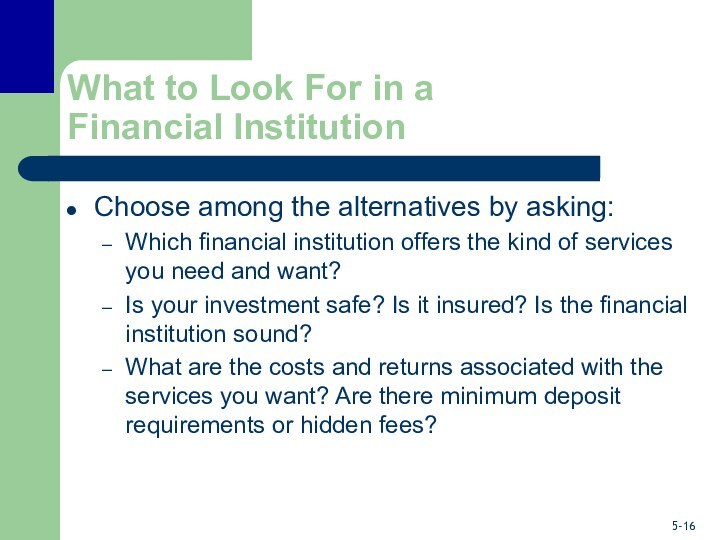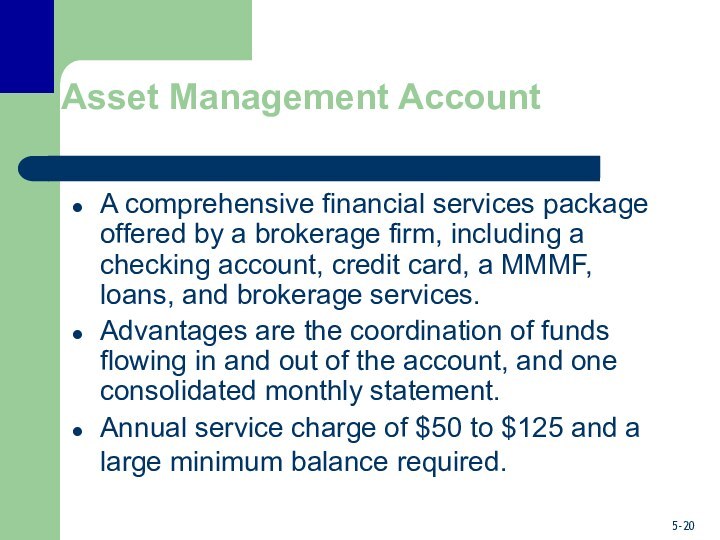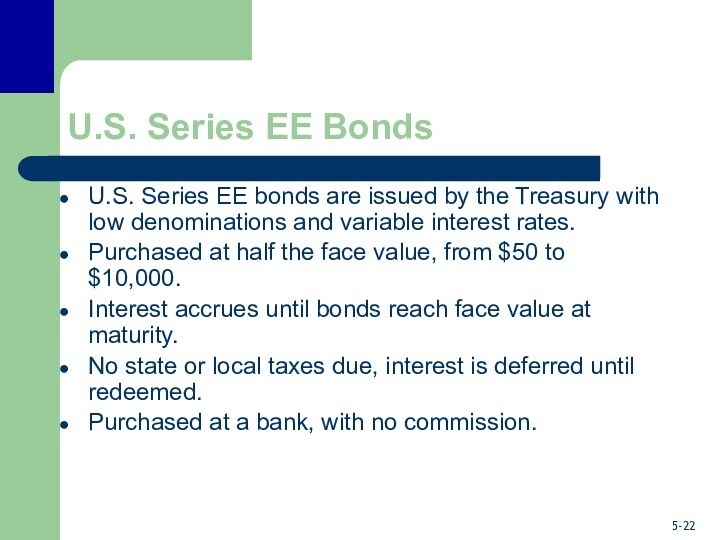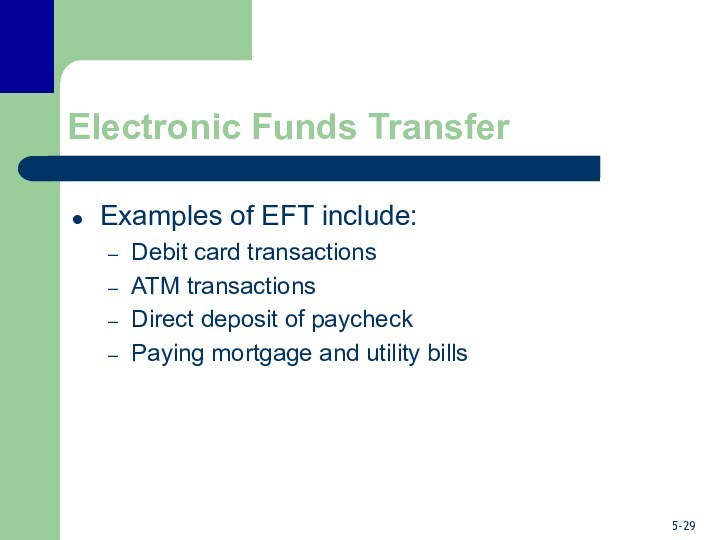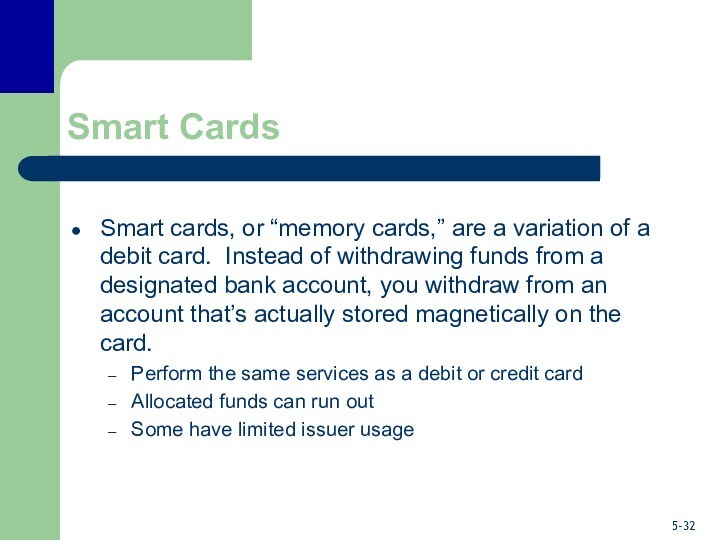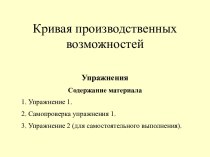Слайд 2
Learning Objectives
Manage your cash and understand why you
need liquid assets.
Automate your savings.
Choose from among the different
types of financial institutions that provide cash management services.
Compare the various cash management alternatives.
Compare rates on the different liquid investment alternatives.
Establish and use a checking account.
Transfer funds electronically and understand how electronic funds transfers (EFTs) work.
Слайд 3
Managing Liquid Assets
Cash management is deciding how much
to keep in liquid assets and where to keep
it.
With less regulation and more competition, banks and other financial institutions offer an array of account types and investments.
Слайд 4
Managing Liquid Assets
Cash management means not only making
choices from among alternatives, but maintaining and managing the
results of those choices.
Liquid assets have little risk and therefore a low expected return.
Слайд 5
Automating Savings:
Pay Yourself First
Use cash management alternatives
to have savings automatically deducted from your paycheck.
Automating
your savings means you are less likely to spend that money.
Remember Principle 13: Pay yourself first
The earlier you start to save, the easier it is to achieve your goals.
Remember Principle 2: The time value of money
Слайд 6
Financial Institutions
Financial institutions are categorized as:
Deposit-type financial institutions
– referred to as “banks”
Nondeposit-type financial institutions – such
as mutual funds and brokerage firms
Слайд 7
“Banks” or Deposit-Type Financial Institutions
Financial institutions that provide
traditional checking and savings accounts are called “banks” or
deposit-type institutions.
Слайд 8
“Banks” or Deposit-Type Financial Institutions
Types of “banks”:
Commercial Banks
Savings
and Loan Associations
Savings Banks
Credit Unions
Слайд 9
“Banks” or Deposit-Type Financial Institutions
Commercial Banks – offer
the widest variety of services including checking and savings
accounts, credit cards, safety deposit boxes, and lending.
15,000 commercial banks in 65,000 locations in U.S.
Offer online banking.
Слайд 10
“Banks” or Deposit-Type Financial Institutions
Savings and Loans –
S&Ls or “thrifts” were originally established to provide mortgages
to depositors.
Слайд 11
“Banks” or Deposit-Type Financial Institutions
Types of S&L’s:
Mutual S&L
– depositors/owners receive dividends.
Corporate S&L – depositors receive interest.
5,000
S&Ls in U.S. with 25,000 offices.
Higher interest on savings than commercial banks.
Слайд 12
“Banks” or Deposit-Type Financial Institutions
Savings Banks – most
are depositor-owned and are found in the northeast part
of U.S.
Are like a mutual S&L because they pay dividends rather than interest.
Primary purpose is to provide mortgages to depositors.
Слайд 13
“Banks” or Deposit-Type Financial Institutions
Credit Unions – not-for-profit
cooperatives established by churches, schools, and corporations, opened only
to members.
Tax-exempt status
Pay higher interest rates than commercial banks
Lower fees and more convenient locations
Слайд 14
Nondeposit-Type Financial Institutions
Mutual Fund – investment fund that
raises money from investors, pools that money, invests it,
and is professionally managed.
Слайд 15
Nondeposit-Type Financial Institutions
Stockbrokerage Firms – offer investments and
a wide variety of cash management tools, including financial
counseling, credit cards, and their own money market mutual funds.
Слайд 16
What to Look For in a
Financial Institution
Choose among
the alternatives by asking:
Which financial institution offers the kind
of services you need and want?
Is your investment safe? Is it insured? Is the financial institution sound?
What are the costs and returns associated with the services you want? Are there minimum deposit requirements or hidden fees?
Слайд 17
Cash Management Alternatives
Cash management alternatives include:
Checking Accounts
Interest
bearing – NOW accounts
Non-interest bearing – demand deposits
Savings Accounts
– time deposit
Слайд 18
Cash Management Alternatives
Cash management alternatives include:
Money Market Deposit
Account (MMDA) – variable interest rates
Certificates of Deposit (CD)
- pays a fixed rate of interest while funds are on deposit for a period of time.
Слайд 19
Money Market Mutual Funds
Money Market Mutual Funds (MMMF’s)
- an alternative to traditional liquid investments.
Draws together
the savings of many individuals, investing those funds in large, creditworthy debt.
Usually a higher yield than bank money market accounts and includes check writing privileges.
Shares are purchased at $1 per share, interest rate changes daily.
Слайд 20
Asset Management Account
A comprehensive financial services package offered
by a brokerage firm, including a checking account, credit
card, a MMMF, loans, and brokerage services.
Advantages are the coordination of funds flowing in and out of the account, and one consolidated monthly statement.
Annual service charge of $50 to $125 and a large minimum balance required.
Слайд 21
U.S. Treasury Bills or T-Bills
U.S. Treasury bills, or
T-bills, are short-term debt issued by the federal government.
Maturities
of 3-12 months
Minimum denomination of $1,000
Very liquid, safe investment
Pay less than face value, mature at full face value. Interest in the form of appreciation.
Слайд 22
U.S. Series EE Bonds
U.S. Series EE bonds are
issued by the Treasury with low denominations and variable
interest rates.
Purchased at half the face value, from $50 to $10,000.
Interest accrues until bonds reach face value at maturity.
No state or local taxes due, interest is deferred until redeemed.
Purchased at a bank, with no commission.
Слайд 23
Comparing Cash Management Alternatives
Comparable Interest Rates – use
the annual percentage yield (APY) to easily compare.
Tax Considerations
– taxes affect the real rate of return on investments.
Safety – some deposits are insured
FDIC insures banks
NCUA insures credit unions
MMMF – not insured but diversified
Слайд 24
Establishing and Using a Checking Account
When choosing a
financial institution, consider:
Cost
Convenience
Consideration
Balancing your checking account –
compare monthly statement with register, then reconcile.
Слайд 25
The Check Clearing Act for the 21st Century
or Check 21
Purpose of Check 21 was to improve
efficiency by electronically shipping checks.
How does Check 21 affect you?
Checks processed more quickly.
Items may differ on statement, listed by check number or name.
Cancelled checks may or may not be returned.
Слайд 26
Other Types of Checks
Cashier’s Check - a check
drawn on the bank’s account.
Certified Check – a
personal check that has been certified as being good by the bank on which it is being drawn.
Слайд 27
Other Types of Checks
Money Order – a variation
of cashier’s check, but issued by non-banks (U.S. Postal
Service).
Traveler’s Checks – similar to cashier’s checks, except they don’t specify a payee and have specific denominations.
Слайд 28
Electronic Funds Transfer
Electronic funds transfer (EFT) refers to
any financial transaction that takes place electronically.
Funds move
instantly without paper.
Слайд 29
Electronic Funds Transfer
Examples of EFT include:
Debit card transactions
ATM transactions
Direct deposit of paycheck
Paying mortgage and utility bills
Слайд 30
Automated Teller Machines
An ATM or cash machine provides
cash instantly and is accessed through a credit or
debit card.
Obvious appeal is convenience.
To use ATM, just swipe card, enter PIN, and indicate amount of cash.
Слайд 31
Debit Cards
A debit card is a cross between
a credit card and a checking account.
Looks like a
credit card but acts like a checking account.
With debit cards, you are spending your own money, as opposed to borrowing money with a credit card.
Слайд 32
Smart Cards
Smart cards, or “memory cards,” are a
variation of a debit card. Instead of withdrawing funds
from a designated bank account, you withdraw from an account that’s actually stored magnetically on the card.
Perform the same services as a debit or credit card
Allocated funds can run out
Some have limited issuer usage





